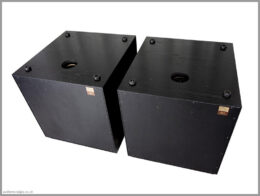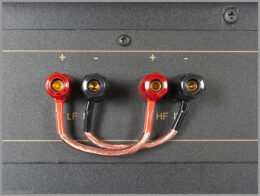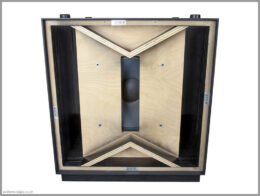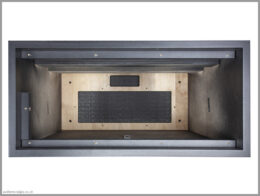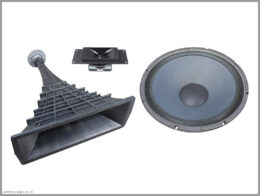TABLE OF CONTENTS
MY STORY WITH KLIPSCH LA SCALA
The first time I came across Klipsch speakers was when I started my adventure with vintage Tannoys, about 15 years ago. While exploring the horn loaded design of Tannoy Autograph loudspeakers, I discovered Klipschorns – an equally impressive construction. From there, I learnt more about the Klipsch brand, and their other loudspeakers such as Klipschorn “smaller” sibling – Klipsch La Scala.
Because I live in the UK, getting hold of vintage Klipsch speakers is even more challenging than getting a set of vintage horn-loaded Tannoy speakers. Similar to vintage JBL speakers, there are just not many of them around in the UK. In addition, UK houses tend to be smaller than properties in other parts of the world (such as the US), thus, even if a person is in a position to afford speakers like these, they may not necessarily have a room to accommodate them.
The good news is that flagship Klipsch loudspeakers like Klipschorn and Klipsch La Scala are still being made, and due to the recent popularity of ‘vintage HiFi’, they are getting a lot of attention from the audiophile community.
Recently, I have been mainly reviewing smaller bookshelf type speakers, however, I really wanted to review something ‘a little bit bigger’ for a change, something different. I knew this wasn’t going to be cheap, so I started putting some money aside and mentally preparing my better half. Imagine my surprise when about 6 months ago I was contacted by a friend who told me about a guy who due a change in personal circumstances had to move to a smaller house, and was selling his Klipsch La Scala II speakers. I contacted the fellow straight away, and we’ve made an agreement.
I knew that these were fairly large, but I did not appreciate how large until I stated measuring my SUV-type car, and I realised that I can only fit one speaker in, and it has to be without the original packaging! This of course wasn’t practical and I ended up hiring a transit van just to be able to transport them safely in their original boxes. It was a long journey and I ended up paying an amount that most “normal” people would consider stupid for a set of loudspeakers, however, it was well worth it for the experience. It is one thing to listen to speakers in a HiFi shop, but a completely different experience to be able to play with them at home for however long you like.
SPEAKER INFO
Model History
Klipsch La Scala were first released to the market in 1963 and were intended for professional use (i.e. public address speakers). Despite their plywood construction and raw appearance, due to their high-quality sound reproduction they gained significant popularity in the US domestic market, and remained in production virtually unchanged until modern times. Yes, there were driver and crossover changes over the years, but it wasn’t until the end of 2005 when Klipsch La Scala II was released as the first ‘domesticated’ version, under the Klipsch Heritage Loudspeakers range. Apart from updated drivers and a redesigned crossover network, the 19mm plywood enclosure was replaced with 25mm MDF enclosure, finished in premium wood veneers (walnut, cherry and black ash). The cabinet was also split into two separate enclosures – most likely to make the handling and shipping easier. Moreover, the previously exposed tweeter and midrange horns were covered with a stylish grille which carries a Paul W. Klipsch badge on it. The Klipsch La Scala II model remained in production until 2016 when it was replaced by Klipsch La Scala II 70th Anniversary, which in turn was replaced by Klipsch La Scala AL5 in 2019. Both of these models feature incremental driver and crossover network upgrades over the La Scala II, but are fundamentally the same construction.
Design and Technology
The cabinets of the Klipsch La Scala II are rather substantial, being nearly 98cm high, 62cm wide and 65cm deep, which results in a back breaking weight of 80kg per speaker. They are a 3 way fully horn loaded construction which is quite rare in the HiFi world. Both, the 2.54cm compression tweeter and 5cm compression midrange driver feature phenolic diagrams and are coupled with exponential horns. The woofer is a 38cm fiber-composite cone enclosed in a folded horn.
For readers not familiar with the concept of horn loading – it is a way of improving impedance matching between dense diaphragm and less-dense air. Unless you are into science, this statement is probably meaningless to you, so let’s use an analogy which may help you with understanding how horn speakers work… If you have a bucket full of light ping pong balls and you hit it in the centre with a heavy hammer, the balls at the top of the bucket will just spread apart and move out of the hammer’s way. Imagine now that you now put the same amount of ping pong balls into a tube of a diameter slightly larger than a ping pong ball, so there is a log line of balls in the tube. If you hit the ball at the back of the tube with a heavy hammer, all of the balls will move rapidly with quite a lot of speed. This perfectly illustrates what the horn does – it basically creates a better coupling between the driver and the air around it, making the driver more efficient. To put it simply, for the same amount of power, horn drivers can normally generate a lot more sound pressure than traditional non-horn loaded drivers.
Why would one care about the efficiency of speakers if these days good quality high-power amplifiers are relatively inexpensive? It’s because, efficiency can bring some benefits to loudspeaker design. One of them is that a diaphragm or cone in efficient speakers has to move less, and if executed properly, this can result in lower distortion. Of course, it is not all rosy, because if the horn loading was the only way to make good loudspeakers, everyone would be doing it. To cut a long story short – loudspeaker design is always a compromise but I am really happy that companies like Klipsch exist and are willing to choose a different set of compromises than other mainstream manufacturers. Variety is a spice of life!
KLIPSCH LA SCALA II SPECS
| Frequency Response: | 51 – 17,000Hz (+/- 4dB) |
| Sensitivity: | 105dB (2.83V, measured at 1m) |
| Impedance: | 8Ω |
| Power Handling: | 100W |
| High Frequency Driver: | K-77-D 2.54cm (1”) Phenolic Diaphragm Compression Driver With an Exponential Horn |
| Mid Frequency Driver: | K-55-X 5.08cm (2”) Phenolic Diaphragm Compression Driver With an Exponential Horn |
| Low Frequency Driver: | K-33-E 38.1cm (15”) Fiber-composite Cone With a Folded Horn |
| Crossover Frequencies: | 400Hz & 4,500Hz |
| Enclosure Type: | Full Horn Loaded |
| Enclosure Dimensions (HxWxD): | 978 x 616 x 641mm (38.5 x 24.25 x 25.25″) |
| Weight: | 80kg (each speaker) |
| Production Year: | 2006 – 2016 |
| Price When Launched: | £9,000 |
LOOK & FEEL OF KLIPSCH LA SCALA II
My wife thinks that Harbeth M40.1 are visually too large for our living room – frankly, any speaker larger than a box of matches would probably be too large in her eyes. You can then imagine her face when I brought the Klipsch La Scala II home in a transit van… luckily she understands and accepts my hobby. To call these speakers large would be an understatement – they are huge. But as you my know if you’ve read my other reviews – I like big speakers, and La Scalas are no exception.
Most of the Klipsch La Scala II cabinet panels are made of 25mm MDF and finished in a real wood veneer, stained or painted depending of what finished you’ve chosen. Veneer wood texture can not only be seen but also felt – looks very premium. Some panels, such as cabinet backs or the inside of the folded horn (commonly known as “dog house”) are made of 19mm plywood and are painted black where visible. The plywood grade used for these is OK but not top-of-the-range, which results in some of the screws holding the back panels ‘denting’ the top layer of plywood. I inspected the screws when I bought the speakers and they looked like they have never been touched. This leads me to believe that this is how Klipsch La Scala II came from the factory. Moreover, with an exception of the bass driver, all other drivers and back panels are held using wood screws as opposed to bolts and threaded inserts. Neither of these things have any impact on the sound, however, I wanted to point them out because I feel these are high-end speakers.
The grilles of Klipsch La Scala II are covered in a high-quality fabric and have great looking PwK logos with copper accents attached to them. They are screwed on from the inside of the cabinet, manning that are not removable during normal usage. The top enclosures are separated from the bottom cabinets using off-the-self rubber feet with metal washers embedded in them to provide a fixing point – a very down-to-earth approach. Bottom cabinets sit on small plinths made of MDF and are equipped with small metal feet. Due to the weight of these speakers, this is not really sufficient to move them on a carpet, and I ended up building trolleys with castors that hide inside these plinths and allow me to easily move the speakers as and when required.
Gold plated bi-wireable binding posts are attached to a metal plate and look to be of a good quality. All of the internal wiring appears to be using high quality and relatively large diameter copper cables. The crossover of Klipsch La Scala II is a fairly complex design and contains 22 components. Among these, you’ll find sandcast resistors, polypropylene capacitors, and a mixture of ferrite core and air core inductors – nice but expected in this price bracket I think.
All Klipsch La Scala II drivers carry PwK logo, and look very substantial. Having said that, I was a little disappointed to see pressed metal baskets of the woofers in the speakers of this magnitude. Also, the internal finish of the midrange exponential horn is a little rough, which explains why the grilles are not removable. Again, I’m being anal about these things because this is a premium speaker. However, things like this are not unique to Klipsch. Most companies use the approach that if something is not visible to the customer, it does not have to look nice or feel premium.
Overall, the Klipsch La Scala II is very well-made loudspeaker. I can definitely see the professional connection where everything is overengineered and made to last. There is no room for exotic materials or audio voodoo – just solid utilitarian engineering. I can easily see them being passed down the generations and becoming a family heirloom.
SOUND OF KLIPSCH LA SCALA SPEAKERS
First Impressions
When I arrived home after several hours spent on a motorway in a transit van, I could not wait to play some music through the Klipsch La Scala II. After my friend and I managed to actually carry them up the stairs and into my living room, I moved my Harbeth M40.1 out of the way and connected the La Scalas. I was expecting to be blown away but I wasn’t. Yes, the sound was quite effortless but I thought guitars did not seem to be as realistic as in my memory of the M40.1s and I just could not get involved. I was quite tired from the journey, so I did not bother doing any more listening that evening. Next day when I was well rested, I put one of the M40.1s on the side of the La Scala II and played some music in mono, just to verify if what I’d heard the night before was correct. Imagine my surprise when it turned out that guitars sounded much more vivid, more open and more life-like on the Klipsch La Scala II than on the Harbeth M40.1. This is a perfect example showing that there is no one easier to fool than yourself, and if you want to compare one piece of equipment to another, you shouldn’t do it from ‘memory’ and definitely not when you are tired. As a matter of fact, I have written a whole article about the challenges of reliably comparing HiFi equipment – have a look if you want to find out more (there is also a YouTube video if you cannot be bother to read).
Comparison With Harbeth M40.1
With that humbling experience out of the way, and because I already had my Harbeth M40.1 at the side of the Klipsch La Scala II, I continued with my mini comparison. It turned out that instruments like pianos sounded more vivid on La Scalas too, but lacked a bit of body. Drums sounded more real too, but lacked some low end extension. Wind instruments sounded a little more open but less warm. Clapping sounded slightly different but equally realistic on both loudspeakers. Although the La Scala II had more sense of air/reverb around the instruments, the M40.1s had more sense of the space in which the recording took place. What the La Scalas lacked somewhat, was the low-end extension, which made the double bass and lower piano notes not as enjoyable to listen as on the M40.1s. Where they really shined though was the voices – they seem to be more open than on the M40.1s and with less sibilance.
However, unless you’ve experienced Harbeth speakers, the above comparison is not going to mean much to you, so let me move onto more of a traditional review as opposed to side-by-side comparison.
First, lets get some misconceptions out of the way… You often hear people criticising horn loaded loudspeakers for having a ‘horn like’ sound, as if you were to put your hands around your mouth and tried to talk. Yes, you may get some of that with poorly designed speakers, but you don’t get any of it the with La Scala II – they sound no different to traditional speakers in this respect, unless you go crazy loud.
Another criticism (usually from people who have never heard well designed horn speakers) is that horn loudspeakers sound bright. Again, this is not all the case with Klipsch La Scala II. As a matter of fact, they are easier on the ears than a lot of ‘normal’ speakers that I have experienced.
Bass
With misconceptions addressed, let discuss how they sound – starting with the bass. What you get is very dry, quick but a rather limited in depth. If like me, you associate dynamics with the pressure you feel in your chest, you may miss it a little. Tracks like Loneliness House by Greg Brown that rely on low end extension, just don’t appear to have that much attack in the lower regions. Klipsch La Scala II just simply don’t go low enough to provide you with that visceral feeling, unless you are playing a recording with a lot of bass and quite loud. A great example of that may be Axel F by Harold Faltermeyer, which sounds fantastic when turned up to a fairly high level. If I was to compare La Scala II to other speakers, I’d say that they provide similar level of low-end extension to medium-size bookshelf speakers. Where they differ is how effortless the delivery is. Yes, they may not dig deep, but you know straight away that you are not listening to small loudspeakers. Klipsch La Scala II can go extremely loud without any signs of compression, loss in control or ear-piercing treble.
The impact of the limited bass extension will be depended on the type of music that you listen to. With songs such as Into My Arms by Nick Cave & The Bad Seeds, where the piano extension and background noises add something to the atmosphere of the recording, you may be missing the bass. On the other hand, on lighter tracks such us Silent Movies by Madisen Ward and the Mama Bear you are not going to miss a thing.
Midrange and Treble
This leads me nicely to the midrange and treble, which are of a very high quality. During the course of the last 6 months, whenever I was listening to any music with vocals, their clarity of voices always caught my attention. Tracks such as Ghost Town by Katie Melua gave me goosebumps. There is something special in how Klipsch La Scala II reproduce voices, not only the tone, but general openness, how focus they are and how easy it is to distinguish between the voices when multiple people are singing in harmony. The quality of midrange and treble is also noticeable in how string and keyboard instruments are reproduced. The attack of the fundamental tones is very life-like. This is where the Klipsch La Scala II excel in dynamics – striking piano keys and plucking guitar strings sounds very good indeed, and this is very noticeable on tacks such as Where Shall I Be by Eric Bibb. They reminded me of Tannoy Little Gold Monitors in this respect.
A lot of loudspeakers struggle with realistic reproduction of clapping, which in my opinion plays a fundamental role in the overall atmosphere of live recordings. Klipsch La Scala II sound very realistic in this aspect and you can clearly hear that on songs such us Bridge Over Troubled Water by Paul Simon from the MTV Unplugged album. Where they may be lacking a little is the reproduction of the ambience of where the recording took place, but you don’t really notice it unless you compare them directly with speakers that do this better. What is also quite good is the sound stage. For some reason, I was expecting to be greeted with a “wall of sound” but I wasn’t. Placement from side to side is spot on and depth illusion is not bad either. Yes, depth is not a good as I’ve heard on some other speakers, however, it is enough to create an impressive listening experience.
Overall Klipsch La Scala II are very special speakers. Even though they may not go as low as I would like them to, their sound is still very engaging and not fatiguing. There were number of occasions where I was playing something in the background at a relatively low level, and then I had to stop doing whatever I was doing because I was distracted by how nice something sounded. To me, that is definitely the sign of a quality loudspeaker.
If I had a living room that was large enough to comfortably accommodate these, I would definitely be looking at using these in my system but definitely coupled with a pair of quality subwoofers.
CONCLUSION
Klipsch La Scala II are very vivid and engaging sounding loudspeakers but somewhat limited in terms of bass extension. Despite this, they are very easy to listen to and not at all fatiguing. Exceptional midrange clarity and great overall transparency.
If your room (and wallet) is large enough to accommodate them, and you are willing to add a couple of good quality subwoofers, you’ll end up with a very special setup.
| Balance of Sound: | |
| Neutrality of Tone: | |
| Transparency: | |
| Soundstage: | |
| Attack: | |
| Engagement: | |
| Total Score: |
SONGS MENTIONED IN THIS REVIEW
Eric Bibb – Where Shall I Be
Greg Brown – Loneliness House
Harold Faltermeyer – Axel F
Katie Melua – Ghost Town
Madisen Ward and the Mama Bear – Silent Movies
Nick Cave & The Bad Seeds – Into My Arms
Paul Simon – Bridge Over Troubled Water (MTV Unplugged)
Reviewed: April 2021 | Published: May 2021






